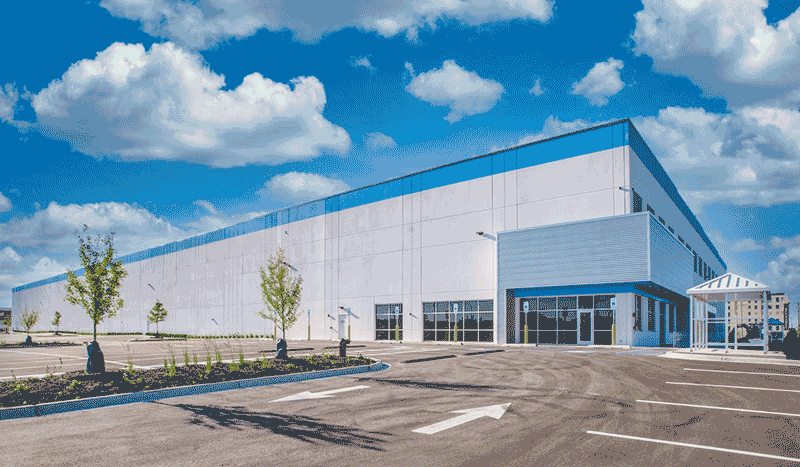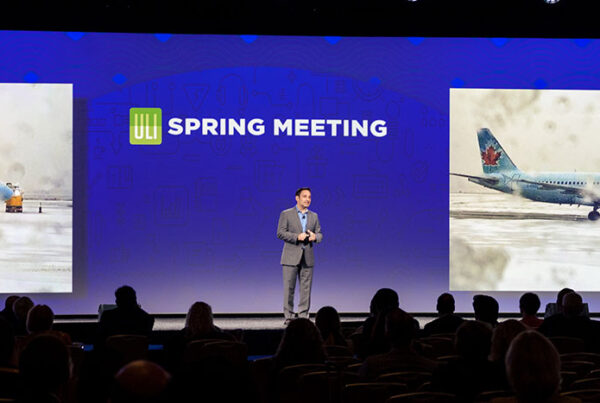
In Chicago, for example, Stonemont purchased a vacant Wrigley Chewing Gum factory in the Bridgeport neighborhood near the city’s downtown. The long-abandoned historic structure was torn down and a 250,000-square-foot (23,200 sq m) warehouse replaced it as a speculative development that was quickly leased. (Stonemont)
![]() The COVID-19 pandemic may have been the impetus for a seismic shift in online shopping for U.S. shoppers, accelerating the need for warehouses close to customers and the workforce.
The COVID-19 pandemic may have been the impetus for a seismic shift in online shopping for U.S. shoppers, accelerating the need for warehouses close to customers and the workforce.
In early 2021, the EY Future Consumer Index, which surveys thousands of consumers, found that 43 percent of U.S. consumers said they shopped more often online for products they would have previously bought in stores, and 60 percent said they go to brick-and-mortar stores less often. Amazon alone added 400,000 workers across the United States, leasing or buying more than 800 warehouses across the country, and other retailers are trying to keep pace.
The ramifications of that shift are many, but one is that consumers have become acculturated to rapid delivery, expecting to receive goods within a day or two of an order. That means the warehousing industry will have to adapt, bringing its facilities closer to consumers—with all the complications that come with moving industrial facilities closer to residential areas.
“It’s really all about maximizing fast delivery times,” says Adrian Ponsen, director of analytics with the CoStar Group in Philadelphia. “The tenants are gravitating toward those infill locations: the pros definitely outweigh the cons.”
Stonemont Financial Group, a real estate firm based in Atlanta, embarked upon a strategy to obtain warehousing space near dense urban areas four years ago and began acquiring some properties in 2019. But events quickly outpaced their plan, and they have had to throw themselves into overdrive to keep up with changing consumer demand.
“This process probably would have taken a lot longer had COVID not happened,” says Zack Markwell, president of Stonemont. “A lot of people did not shop online and all of a sudden they were forced into that.”
Markwell believes that the industry, and community preferences, have been permanently adapted so that people will be more prepared in the future.
“Should something like a pandemic happen again, we’re trying to really create the supply chain so folks can still purchase goods, sitting in the comfort of their own homes, and be able to get what they need,” says Markwell.
In Chicago, for example, Stonemont purchased a vacant Wrigley Chewing Gum factory in the Bridgeport neighborhood near the city’s downtown. They tore down the historic structure and planned a 250,000-square-foot (23,200 sq m) warehouse as a speculative development. Sure enough, it was seen as a prize for its proximity to dense neighborhoods and was quickly leased out.
The Wrigley factory is a holdover from a previous era of American industrial development, when factories and warehouses were speckled throughout working-class neighborhoods and urban downtowns (which is part of why those areas did not gentrify before deindustrialization). But the dual forces of white flight and capital flight sent residents and capital to the edges of metropolitan areas, leaving many of these historic industrial structures abandoned or (in a few cases) repurposed into condominiums and apartments.
“Historically, we look at industrial [development] as manufacturing and dirty facilities,” says Markwell. “Today, we’re building classic facilities that look almost like office buildings. We look at this as the new face of retail, versus the traditional stigma of industrial.”
While the support structures for online retail are not as polluting or disruptive as old-school heavy industry, they can still be disruptive to surrounding neighborhoods. Online retail companies have faced criticisms for causing traffic, crashes, and other side effects of injecting more heavy and light trucking into an already heavily populated area.
For the companies there are other downsides of these locations as well. Greenfield exurban land values are generally much lower than those in urban areas, adding to expenses. Relatedly, parking lots too are much smaller. Neighbors may be annoyed by higher volumes of truck traffic, but on the other side congestion is also a hurdle that delivery vehicles need to clear.
But Ponsen of CoStar Group says that the advantages outweigh these downsides.
“Maximizing delivery time is such an advantage, and then there’s access to labor,” he says. “It’s much easier to source people to work in these distribution facilities when they’re in dense urban areas than when they’re in these areas with really low population density.”
Markwell says that Stonemont Financial Group does not see so-called Not In My Backyard (NIMBY) activists as backlash, per se. After all, groups who may oppose a new distribution center are almost invariably the same consumers who demand fast delivery and turnaround speeds.
For Markwell, many of these communities already have these kinds of distributional facilities in their midst, like bakeries and mail-sorting facilities. They may just not understand him as delivering a similar kind of service to the ones they have always known. If new is threatening, then education and outreach are the way to overcome wariness.
“We have had certain parts of the country where the educational process takes a little longer than others, where some folks say that it’s just not the right area,” says Markwell. “But we spend a lot of time before we pursue a project getting to know the neighbors, getting to know the community, and finding out if this is a need that they are supportive of.”
It helps that most of Stonemont’s buildings don’t have homes immediately adjacent to them. There is a former Frito Lay distribution facility that has been transformed into an e-commerce warehouse outside Atlanta and a vacant mall in Birmingham, which they have since demolished and turned into a delivery center that will be fully operational this fall.
For Markwell, the Birmingham story is a case study of how to win over skeptics. The Century Plaza shopping mall had been a hub of the community, but it shuttered in the wake of the Great Recession. When Stonemont obtained it, the structure had been empty for a decade. Neighborhood residents had hoped that it would eventually reopen. Instead, they are getting a 210,000-square-foot (19,500 sq m) e-commerce hub.
“That was a classic case of us having to sit down with the community and really educate them that this is the new format of a shopping mall,” Markwell says. “Instead of coming in and shopping for your goods in person, we’re building the new form of retail.”
Learn more about innovative developments in Chicago at the 2021 ULI Fall Meeting.



